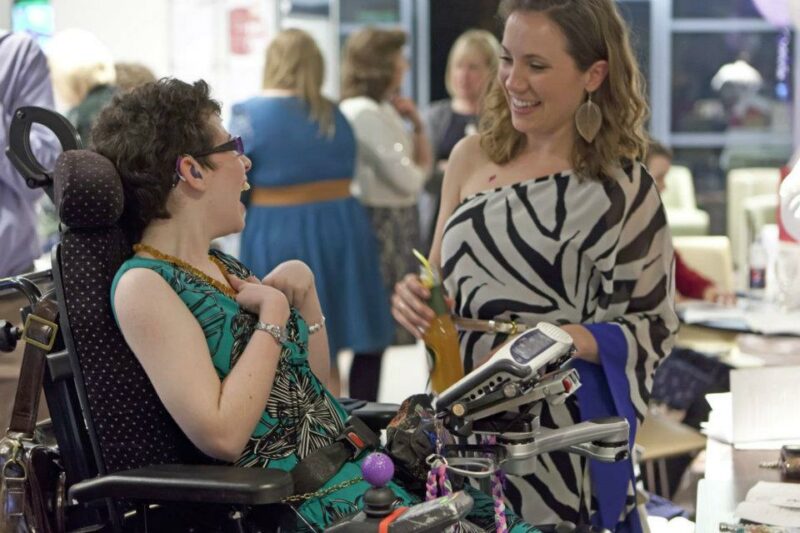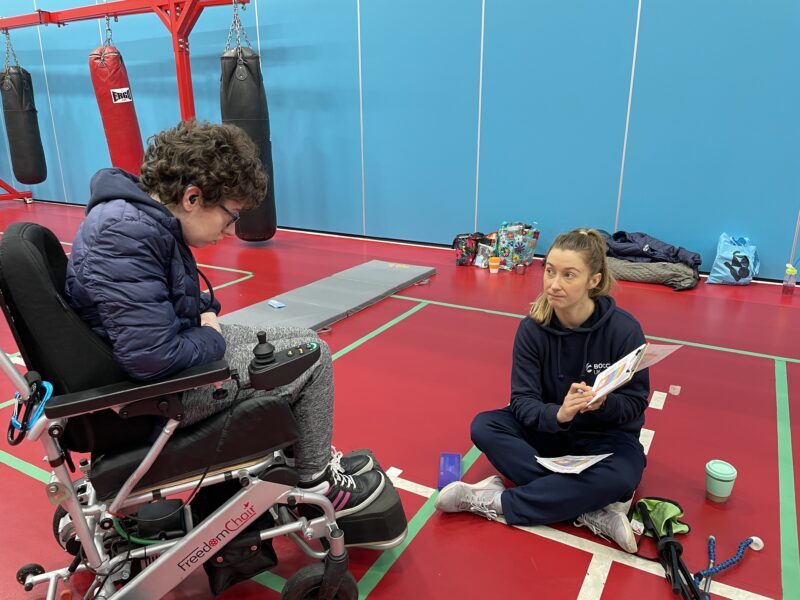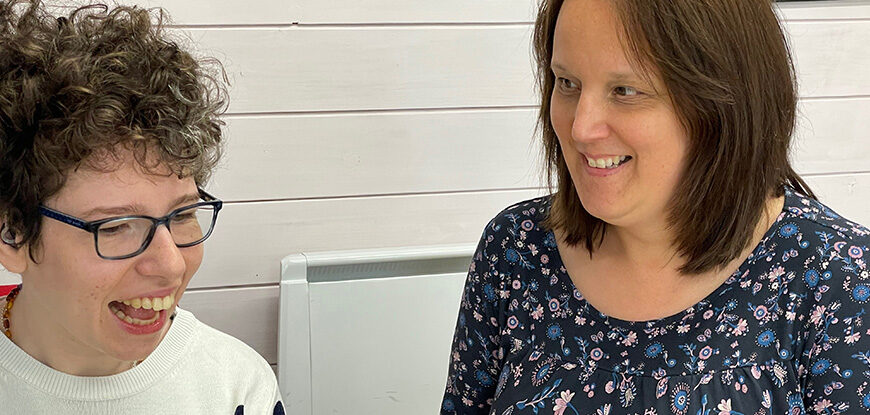I feel the key to good communication is having skilled communication partners. As an AAC user, my life is made immeasurably better by great facilitators who demonstrate active listening skills and who model for others their excellent communication. In any interaction, there is a giver of information and a receiver of the message. When you have difficult to interpret speech like mine, or are using a communication aid, it is important for a communication partner to demonstrate they have understood correctly what is being said, and help others feel relaxed talking with you. This page contains some of my tips for active listening that work for me to avoid communication breakdowns.
Good communication partners are active listeners.
For me, an active listener is not just hearing what I say but is paying attention, being aware of my body language and facial expressions, showing patience, and demonstrating they understand what I’m saying.

Skills demonstrated by active listeners
When someone new starts to work with me I do specific training. It is really important they become great communication partners quickly. The key to this is developing active listening skills. Sometimes this skill takes time to develop, and other people already have the skills but maybe don’t realize it. Making people consciously aware of these skills is really beneficial.
In day-to-day interactions, I like communication partners to demonstrate that they have made a conscious decision to listen to me by:
- Stopping whatever else they are doing.
- Giving verbal affirmations they are listening, such as saying yes, or mmm.
- Demonstrating non-verbal clues such as a smile, nod, eye contact, modifying their posture (lean in or to side), putting their head on their side or hand, mirroring facial expressions.
- Avoiding distractions such as looking at their phone or watch, doodling, or fidgeting.
Reflective listening
Because I also use verbal communication, which is often unclear, I like my communication partners to demonstrate some empathic listening skills. In the early days of working together this means I like them to mirror what I am saying, so repeating each word or short phrase to show they have understood. As we grow together in confidence we move to paraphrasing where they might not repeat every word, but just keywords or a summary. The importance of both mirroring and paraphrasing is not judging what I’m saying, or asking questions, but showing comprehension, before they respond in the interaction.
Interpreting emotions and feelings

When I was younger, before I had the emotional intelligence and vocabulary to explain my feelings In the early days I found it useful for my communication partner to support their understanding by interpreting my body language, alongside the words I was saying. A good way of doing this was assessing the intensity of my emotion on a scale of ‘you feel’ a little bit, quite, a lot, really, very…..
Providing thinking time
In my blog post Thinking time or a mind blank, I also explain how my mind works. As a visual thinker, the importance of a communication partner giving me a second or two thinking time to process my thoughts is essential. Both as a verbal speaker and someone who uses AAC it isn’t always easy to retrieve and physically impart what I want to say without considerable conscious effort.
Passion versus chunking
I can sometimes get carried away when I am passionate about things. This means I barely stop for breath and just keep on talking. Unfortunately, this makes it harder for my communication partner. At times like this I need to inhale, then remember to chunk. Chunking is saying what I want in smaller sound bites, something easier for the listener to process. I also know I might need to use my communication aid, but again I need to chunk. This is important as listeners can only hold a finite amount of dialogue in their working memories. Programming spontaneous speech can be time-consuming and communication partners can easily switch off if they are waiting too long for a message to be prepared.
Key to good reflective listening:
- Be natural.
- Listen to the basic message – Content, Feelings, and Emotions.
- Reflect back in a simple clear fashion.
- When mirroring or paraphrasing check my body language as well as verbal clues that you have understood correctly. I may not want to disagree with you.
- Don’t question, add, embellish or interpret whilst you listen.
- Avoid deflecting to a different topic, stick with the point I’m making.
- Remain non-directive and non-judgemental.
The right to free speech
It is always tricky when asking a communication partner to translate. I prefer it when they verbatim repeat what I am saying. This strategy works well because the listener has already heard me say it and the intonation of the repetition mirrors my output. It also gives the listener the confidence that the answer that is being translated is mine.
Active listening is only the start, or a part, of any interaction
I hope and expect my communication partners to be able to have meaningful and purposeful conversations. This means besides active listening they can probe for information, clarify what I’ve said, and summarize a point. In any two-way interaction then I expect to also do the same. For instance by asking them questions, listening to their reply, seeking more information, and showing I’ve understood.
Modelling good communication skills
Many people can be afraid of talking with someone who uses AAC. It can also be challenging for someone to approach me and my communication partner in new situations. To make people feel more comfortable and know what to do we make it our personal mission when out and about to demonstrate good communication skills. We do this by modelling the skills we know are important. Below you can find lots of different resources that give tips on how to do this.
6 Resources I’ve made to support communication partners
- What I like and dislike about being a communication aid user https://www.youtube.com/watch?v=-YFnV0IWBUg&t=55s
This was my first ever AAC video, made when I was 11. It all still rings true today. And listen up, when I first got my communication aid they all had American voices, fortunately, that’s not the case these days. - ‘Listen to Me’ Video
A collaborative 1 Voice teenage production. My friends and I made this DVD in 2006 to share with people how we would like to be communicated with. I can’t believe how young we all looked. https://www.youtube.com/watch?v=9Cw2Fp_TIfc - How professionals can help young people who use AAC
Professionals play a big part as communication partners in the lives of disabled young people. Here is my dress rehearsal for the 1 Voice Presentation at the Communication Matters conference in September 2009. I was asked to speak about how professionals can help young people who use AAC http://www.youtube.com/watch?v=anO37UysrPM - The importance of role models
I’ve been lucky to have had great role models who use AAC since I was around 8 years old. Mostly they have been people I met at 1 Voice and then at the ISAAC conferences. Toby was my first AAC role model, in 2006 I nominated him for the BT ChildLine Superhero Award which he won. This is what I said about him at the time http://www.youtube.com/watch?v=vZj6so6Ryi0 - Multi-modal communication
I sometimes think I’m labelled as a high-tech communication aid user, because that is what is visible immediately. However, in reality, I use lots of different ways to communicate. This short video made in 2009 shows How I communicate - Moving onto university
Transitioning to university meant finding new communication partners. I created this short video when I first went to university to be shared with staff and students on my course. Before starting it became obvious some people were a little anxious about working with me. As a result, this was my attempt to share that just because I have a disability and use AAC I’m no different from everyone else.
10 ways to support learning to use an AAC device as a communication partner
My Mum found something similar to this when I was 5 or 6, and adapted it for me. It hung on our wall at home so visitors could get some tips on the things I liked and that supported my communication. Whilst everyone is different these 10 points still resonate with me today as being good protocols for communication partners.
- Please be patient
I like it when you take time with me. Communication is hard work, it takes me time to find the words I want to say. Using AAC is like learning a new language and so I have to think very hard to find the words on my device. - Look at me when we talk
It is nice to know that you are interested in what I am saying. My head might be down whilst I am programming but I like it when you are paying attention to what I am doing. It helps if you are at my level. Your being positive encourages me to keep going. - Let me finish my own sentences
It feels good when you don’t try to guess what I am saying. I like to finish my own sentences, even if you think you might know what I’m trying to say. Indeed I also like it when you wait and don’t look over my shoulder whilst I’m programming. - I like it when we take turns speaking
Thank you for listening to me, it makes me feel really good when we take turns to talk. I also like it when you ask open questions, ones that start who, what, where, when, how, or why. It is boring if I only get to answer yes or no, although there is a place for closed questions. - Allow me to answer for myself
I value your input when you model good communication with me to other people. This helps them know what to do when they are with me. Thank you for not answering for me. - Show you understand what I am saying
I like it when you confirm you have understood what I am saying. If you re-phrase it then I am also learning other ways of saying the same thing. I do know when you don’t understand me, so I prefer you don’t pretend you do. - Remember all communication is multi-modal
I really like it when you watch my facial expressions and body language for clues as well as listening to the words I say. If you need additional help then I can show you with gestures, my eyes, answering questions, or using props around us. - Help me to stay calm
I’m grateful if you realize I am struggling and help take the pressure off. Sometimes I can get flustered when I am asked to use my device, especially when I am tired or need a break. - Sometimes I need a break
I appreciate when you recognize I am getting tired, communication takes a lot of energy. I can find it hard when I am hungry or tired. And, I like it when you ask me if I want to come back to something later. - Treat me with respect
I like it when you praise the effort I am making and encourage me to keep trying hard. I’m not a baby so I appreciate it when you talk to me like I am my age.
Finally, 8 top tips when communicating with me
- Always make sure I have my communication device, wherever I am
Even in the bathroom I often use an alphabet card, technology and water don’t mix 😊 - Please don’t be scared of talking to me
I’m just like you, it just takes a little longer for me to reply. - Look at me when we talk
I need to lip-read because of my hearing impairment. - It helps if you are on my level
If possible please sit down when you talk to me. - Talk to me please, not my assistant
My assistant will not answer for me. - Don’t look over my shoulder when I’m programming
Or guess what I’m trying to say. - If you don’t understand me then repeat or rephrase what I’ve said
Never assume as we just end up with a communication breakdown. - I prefer you to use open questions: who, what, where, when, how, why
Yes and no answers might be quick, but boring for both of us.
You might also enjoy reading:
AAC, video conferencing and communication partners
Boccia and Teamwork, no communication allowed
Thinking time or a mind blank?


If you found this interesting or
helpful please feel free to share.